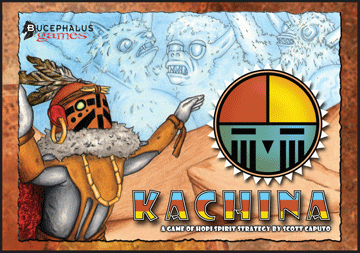Tabletop Game of the Month

Kachina
Bucephalus Games
MSRP: 29.99 USD (Available for around $21.00 online)
Designed by Scott Caputo
The Spin: “A Strategy Game of Dominance Among Spirits!”
The Story: Kachina is a tile-laying game loosely themed around the idea of battling Hopi spirits. Players take turns playing tiles to the board that represent various spirits. All of these have numbers that represent the strength of the tile while some also have special powers. The central idea is to place a tile so that it is the dominant spirit in a row or column. If the player manages to do this, he or she gets points equal to the number of tiles in the row or column.
The Play: Players start with five tiles from the overall mix of sixty. These tiles are of eight different types, all representing various Hopi spirits. It is important that every player begin the game familiar with all of the different tiles, especially the six with special powers. They are as follows:
The Chief (8 STR and no special power)
The Sun (7 STR and no special power)
The Koshari (1 STR, special power—causes adjacent tiles' STR to go to zero)
The Ogre (6 STR, special power—prevents other tiles from being placed next to it)
The Wolf (4 STR, special power—each wolf in a row or column adds its value to each other wolf)
The Warrior (3 STR, special power—can be switched out with tile already on board)
The Hummingbird (2 STR, special power—dominates row or column that is bookended by Hummingbirds)
The Eagle (5 STR, special power—may be played directly on to of another tile)
The game has a very simple rhythm from the start. The first player plays a tile to the table and immediately scores one point. If the second player is able to play a tile that is higher in strength than the one on the table, her or she does so and scores two points. This continues around the table. If a player is unable to place a tile that scores, he or she can still play to set up a later score or just to shed a useless tile. This back and forth continues until all tiles have been played. The player with the highest score wins.
The game really is just about as simple as it sounds. The only complexity comes from the interactions of the various Hopi spirits and from trying (though it is usually fruitless) to set up for a big score later in the game. All of the possible interactions between tiles are covered in the well-written, copiously illustrated rule book, though I'm not sure we consulted the rules at all after the first game.
My Take: The only real complaint I had during our review sessions was, despite the claims on the box, “strategy” was pretty much non-existent. Because the tiles that are played by the opponents change the board situation so much, it is pretty much impossible to look ahead. It is possible to get lucky after placing, for example, a Hummingbird tile and have the the game come back around with the opportunity to dominate a row or column, but, more often, another player will benefit from your play before you have a chance to.
Instead of looking ahead a few moves into the future, Kachina is about maximizing the value of your current play. The real fun of the game comes from placing a tile that manages to dominate both a row and a column for a bunch of points. Noticing these opportunities is, perhaps strangely, feels a lot like multi-player Scrabble. It is a real joy to place a tile in a way that the other players just did not see.
Overall, we found the game to be fast and fun. One group I played with had a bit of analysis paralysis, and I could see the need for maximizing the value of each play causing that with other groups. Outside the games with that group, Kachina played at the low end of the 30 to 45 minutes quoted on the box.
Components: The tiles are heavy and very glossy. Despite the business of the spirit drawings, it is easy to see the STR values of the tiles from across the table. I really like that the tiles have tiny graphics showing how they are played on them. These are too small to view clearly on the table, but they were nice little reminders when I scanned my hand of tiles between turns.
On the negative side, the tiny tiles used for tracking score are too small and too similar in color. In the normal lighting of our game room, none of the players could tell the colors of three of the scoring tiles apart. I replaced them after the first game with stackable plastic chits from another game. Another group of friends simply started keeping score with pen and paper.
Score: 4 out of 5
Pros: Easy to learn; every game seems to go down to the wire
Cons: Scoring tiles to similar; Could drag with some groups
Contest--Win our Tabletop Game of the Month!
Sorry, Contest is closed. Congrats to the winner!
All you need to do is send an e-mail to nerdbloggers@gmail.com with the subject heading "Kachina Contest" and in the body of the message include the title of the classic game that is mentioned as a comparison in the review. That's it. We will pick a winner at random at the end of the month and that reader will get a brand new, sealed copy of Kachina courtesy of Nerdbloggers and Bucephalus.